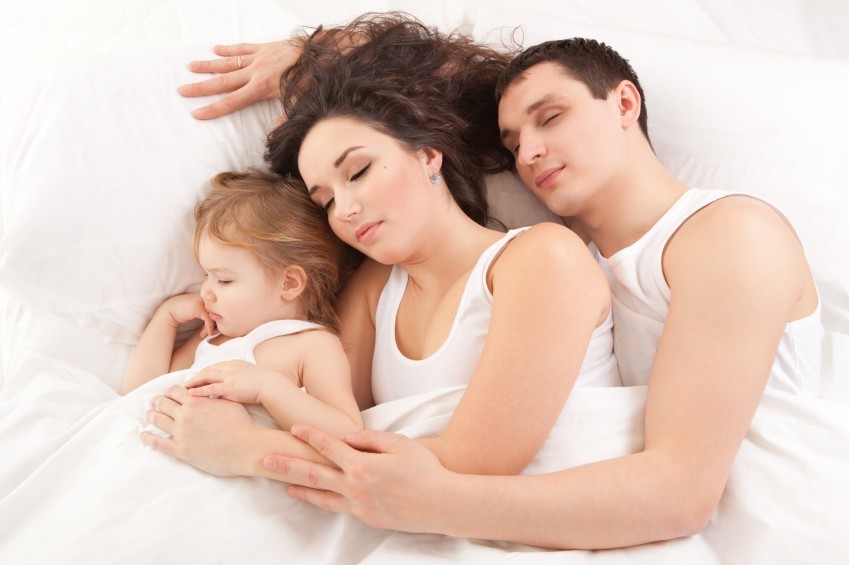Co-sleeping refers to sleeping with your child. Either in the same room or in the same bed (with a bed suitable for co-sleeping).
What is co-sleeping?
Co-sleeping is an ancient practice, which only disappeared recently (+/-150 years). Until the 19th century, children shared their parents’ bed. In small homes, this saved space and warmth and also made breastfeeding easier.
Things have only changed due to new societal norms. Today, the marital bed is considered to be the reserve of the couple only. Furthermore, modern medicine and psychoanalysis recommended that children learn to sleep alone. Co-sleeping therefore took a back seat.
Today, the practice is coming back and developing more and more.

Why use a co-sleeping bed?
There are beds specially made for co-sleeping. These cots or co-sleeping beds allow the child to sleep in the same room as their parents. Reassured by proximity, the child still benefits from a space of their own. The mother still enjoys the benefits, particularly with regard to ease of breastfeeding. Parents can keep their marital bed while the baby sleeps safely in their co-sleeping cot.
What are the benefits of co-sleeping?
Sleeping in a co-sleeping bed has advantages for both the mother and the child.
- The child feels reassured: Skin-to-skin contact is encouraged, giving baby the confidence necessary for their proper development. By sleeping with their parents, the baby receives increased attention and supervision from them. A high number of gestures have been observed, that are intended to check on their wellbeing; such as hugs and caresses. The mother generally does this even while sleeping, instinctively. Evening separation also generates a real feeling of abandonment; co-sleeping avoids waking up alone (in the dark), which is very distressing for a newborn.
- Reduced crying: Co-sleeping allows the child to be heard immediately and for their need for food to be met quickly (their young body cannot tolerate waiting).
- Mother-child relationship: Greater closeness is established between the mother and her child. They can observe their movements while sleeping, and hear their slightest murmurs. Direct communication is established between the two, most often unconsciously. It also develops the mother’s self-confidence. The good image she has of herself thanks to the pleasure and satisfaction of having her baby near her. Through being able to reassure them at any time. This also promotes their relationship with their child. This brings mother and child closer, particularly if the mother works away from her baby during the day
- Reducing the risk of sudden infant death syndrome: A baby who sleeps in a co-sleeping bed is more often in a light sleep phase, which is an excellent means of prevention of sudden infant death syndrome. The baby and mother will in fact wake up more often, and these multiple awakenings act as a protective mechanism. Conversely, when a baby sleeps alone in their own bed, they will sleep more deeply. At an age where awareness mechanisms are not yet developed, this is not optimal.
In a co-sleeping bed the child is always positioned lying on their back, or face-to-face with the mother; this second position allows the child to inhale part of the co2 released by the mother, which increases respiratory movements in the child, as in all mammals, which reduces the risk of dangerously prolonged apnea.
- Breastfeeding is encouraged: this allows the mother to rest better and improves the optimal establishment and continuation of breastfeeding. Studies have shown that co-sleeping mothers breastfeed their babies up to three times longer than others.
- Improved sleep quality: Co-sleeping allows the mother and child’s sleep to become synchronised. This way, the mother feels like she has had better quality sleep than if she had woken up to the sound of the baby’s cries to go and feed them. She therefore feels less tired
What are the risks of co-sleeping in the parents’ bed?
The main risk of co-sleeping is suffocation. In fact, when adults enter a deep sleep phase, they can forget that there is a child in their bed. Parts of the parents’ bed (pillows, sheets and duvets) can also put the child in danger. Other risks are falling from the bed or becoming tangled or trapped in parts of the parents’ bed, such as between the mattress and the box spring or the headboard, for example.
There is also a risk of hyperthermia to be highlighted, if the child has too many covers on them.
Another danger is the fact that the child is always present, which signals the end of intimacy for the couple.
Up to what age can you co-sleep?
There is a question of how long to continue co-sleeping, for the wellbeing of the child and that of the parents. A little one’s need for security during the night generally aligns with the breastfeeding period, which can last up to the third year. Beyond this period, it is most often considered that starting nursery school is the right time to end co-sleeping.
In order to prepare the child for the transition to their own room, they must get used to sleeping alone, particularly by using their own room for naps and playtime. And the bed should never be used as a form of punishment.